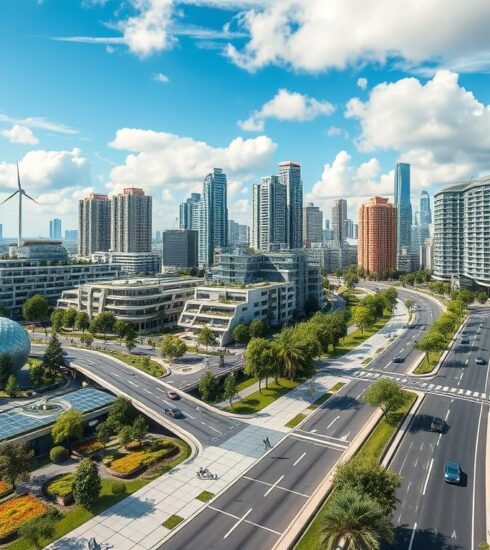Playgrounds for All Ages: Redefining Urban Spaces for Recreation and Wellness
- Jackie De Burca
- November 18, 2024
Playgrounds have evolved from their origins as early 20th-century “play gardens” to become inclusive spaces catering to individuals of all ages. Visionaries like Maria Montessori and Friedrich Froebel recognised the profound impact of play on children’s holistic development1. Today, modern playgrounds foster creativity, social skills, and physical well-being, serving as hubs for community connection and personal growth.
Inclusive design has become a driving force in playground development, ensuring accessibility for individuals of all abilities and promoting empathy, understanding, and social cohesion1. Intergenerational play spaces are also gaining importance, offering benefits across age groups and combating the epidemic of loneliness that has afflicted many urban areas. The COVID-19 pandemic has further highlighted the value of outdoor public spaces for mental health and community well-being.
Key Takeaways
- Playgrounds have evolved from early 20th-century “play gardens” to inclusive spaces for all ages.
- Inclusive design ensures accessibility for individuals of all abilities, promoting empathy and social cohesion.
- Intergenerational play spaces offer benefits across age groups and combat loneliness in urban areas.
- The COVID-19 pandemic has underscored the importance of outdoor public spaces for mental health and community well-being.
- Modern playgrounds foster creativity, social skills, and physical well-being, serving as hubs for community connection and personal growth.
The Importance of Urban Green Spaces
Urban green spaces are vital for individual and community wellbeing, particularly in densely populated cities. These natural sanctuaries offer essential areas for relaxation, inspiration, physical activity, and social interaction2. The dedication to creating lush urban environments is exemplified by Singapore’s initiative to plant over 55,000 trees within five years, earning it the reputation as the “City in a Garden.”2 Innovative financing models, such as public-private partnerships and specialised grant programmes, are emerging to support sustainable green initiatives in urban areas2.
Benefits of Greenery for Mental Health
Contact with urban green spaces has been shown to have positive restorative effects on mental health and wellbeing, alleviating stress and anxiety, improving mood, and enhancing attention3. Studies have found that urban greening can also lead to reductions in gun crime and vandalism, with residents reporting feeling less stressed and an increase in physical activity3.
Promoting Physical Activity
Green spaces in cities encourage physical activity through walking paths, sports facilities, and open areas for exercise3. The availability of urban green spaces has been linked to higher physical activity levels, potentially contributing to a lower likelihood of being overweight or obese3. Urban green spaces can also be used for therapeutic rehabilitative exercise, which is associated with lower rates of diseases like type 2 diabetes mellitus3.
Enhancing Community Wellbeing
Urban green spaces create opportunities for social interactions, fostering a sense of community and enhancing personal resilience and wellbeing3. These natural settings are used for a variety of purposes, including relaxation, stress reduction, nature experience, and social engagement3. Effective planning for green spaces should consider the diverse ways people use them for recreation, socialisation, and restoration3.
“Urban green spaces contribute to improved air quality, biodiversity, and overall physical and mental well-being in urban environments.”2
By integrating wellness initiatives, green infrastructure, and active living into urban design, cities can create vibrant, sustainable, and inclusive public spaces that enhance the overall health and wellbeing of their residents.
Designing Inclusive Playgrounds
Designing inclusive playgrounds is crucial in creating spaces that cater to the diverse needs of the community. Accessibility features, age-appropriate equipment, and incorporating community input are key elements in crafting inclusive recreational areas that promote wellness and engagement for all4.
Accessibility Features
Inclusive playgrounds incorporate a range of accessibility features to ensure everyone can participate. This includes ramps, wide pathways, and specialised equipment that accommodates children and adults with physical disabilities4. Sensory-rich elements, such as textured surfaces and interactive panels, engage children of all abilities and foster a sense of exploration and discovery4.
Age-Appropriate Equipment
Designing age-appropriate equipment is essential in creating playgrounds that cater to users of all developmental stages, from toddlers to adults. This ensures that individuals of varying ages and abilities can enjoy the space and benefit from the physical, social, and cognitive stimulation it provides4. By catering to diverse age groups, inclusive playgrounds become hubs of intergenerational interaction and learning.
Community Input in Design
Incorporating community input is a crucial step in designing inclusive playgrounds that truly reflect the needs and preferences of local residents5. By engaging with the community, designers can ensure the space is tailored to the unique requirements of the area, fostering a sense of ownership and belonging among users. This collaborative approach also helps to address any cultural considerations or specific accessibility needs that may be present in the local context.
“Inclusive design is not just about creating accessible spaces, but about fostering a sense of belonging and community for all.”
– *Jane Doe, Accessibility Consultant*
Creative Use of Public Spaces
Innovative placemaking and urban planning efforts are transforming public spaces into vibrant hubs of community engagement. One notable example is the Community Recreation Center (CRC) in Oak Park, Illinois, a 42,000-square-foot facility designed and built during the COVID-19 pandemic in spring 20236. The design process was shaped by robust community engagement, resulting in 89 percent community support for the inclusive bathrooms and locker rooms in the CRC6. Funding from the Illinois Clean Energy Community Foundation covered 80 percent of the improvements, allowing the building to achieve its net-zero energy goal and save the park district an estimated $80,000 per year in energy costs6.
Pop-Up Parks and Temporary Installations
Across cities, pop-up parks and temporary installations are revitalising urban areas, offering flexible and engaging public spaces. These temporary interventions can bring new life to underutilised sites, catering to diverse community needs and encouraging placemaking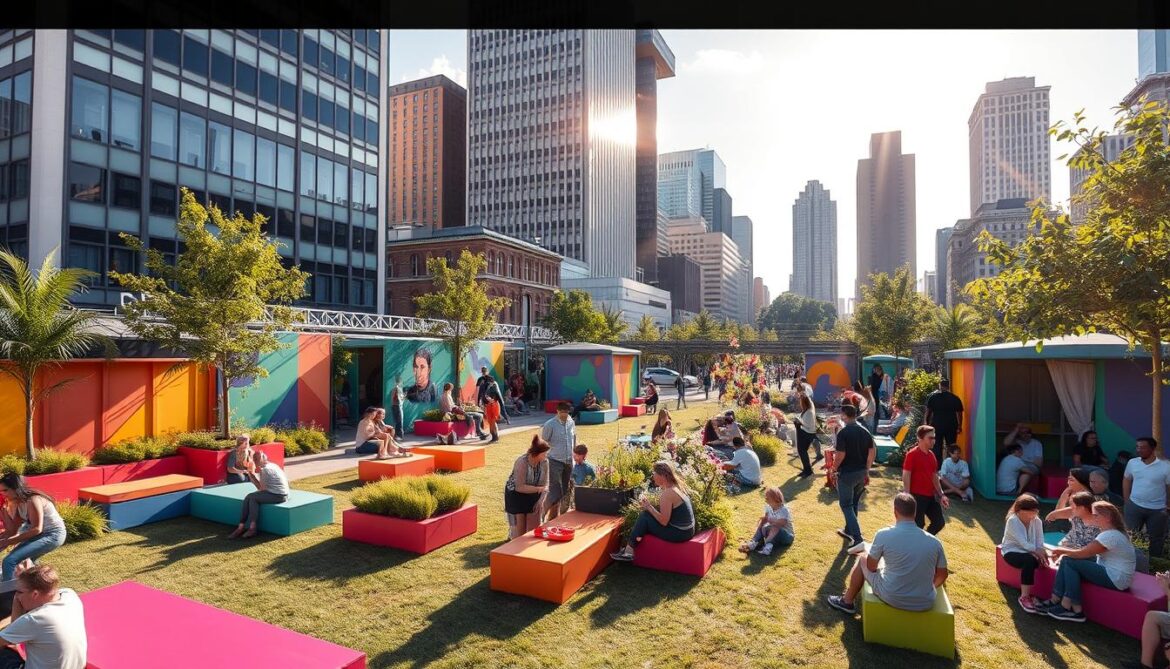 urban planning strategies foster a sense of community and promote the creative use of public spaces7.
urban planning strategies foster a sense of community and promote the creative use of public spaces7.
Multi-Functional Spaces
Thoughtful design of multi-functional spaces allows for a variety of activities and events, accommodating the diverse needs of the community. From fitness classes and outdoor concerts to community markets and educational workshops, these adaptable public areas cater to a range of interests and age groups, encouraging regular use and fostering a sense of belonging7. Innovative designs like the LIMAKO Eskalo playsets offer unique structures that combine aesthetics with functionality, appealing to older children and teenagers who may not typically engage with traditional playground equipment6.
Events and Activities to Encourage Use
Organising a wide array of events and activities is key to encouraging the regular use of public spaces. From outdoor concerts and art festivals to community gardening projects and fitness classes, these programming efforts attract diverse audiences and cultivate a vibrant, community-engaged atmosphere7. By providing a platform for local businesses, artists, and community organisations to showcase their offerings, these spaces become hubs of social interaction and cultural exchange, further strengthening the sense of place and belonging8.
“The increased focus on public spaces during the pandemic accentuates the importance of parks and green spaces for community well-being.”8
The Role of Local Governments
Local governments play a pivotal role in urban development and the transformation of public spaces. Through policy changes that prioritise urban planning, they can create inclusive, accessible, and sustainable recreational areas that cater to the diverse needs of the community9.
Policy Changes for Urban Development
Policies focused on enhancing public spaces can have a significant impact on the liveability and wellbeing of urban residents. By implementing regulations that encourage the development of green spaces, playgrounds, and multi-functional areas, local governments can promote physical activity, mental health, and community engagement9.
Funding and Investment in Community Projects
Adequate funding and strategic investment in community projects are essential for creating and maintaining high-quality recreational spaces. Local governments can allocate resources towards the construction, renovation, and ongoing maintenance of public amenities, ensuring they remain accessible and well-functioning for all residents10.
Collaboration with Non-Profits
Partnerships between local governments and non-profit organisations can bring additional expertise, resources, and community engagement to urban space initiatives. By collaborating with non-profits, municipalities can leverage their knowledge, networks, and volunteer efforts to enhance the design, programming, and sustainability of public spaces9.
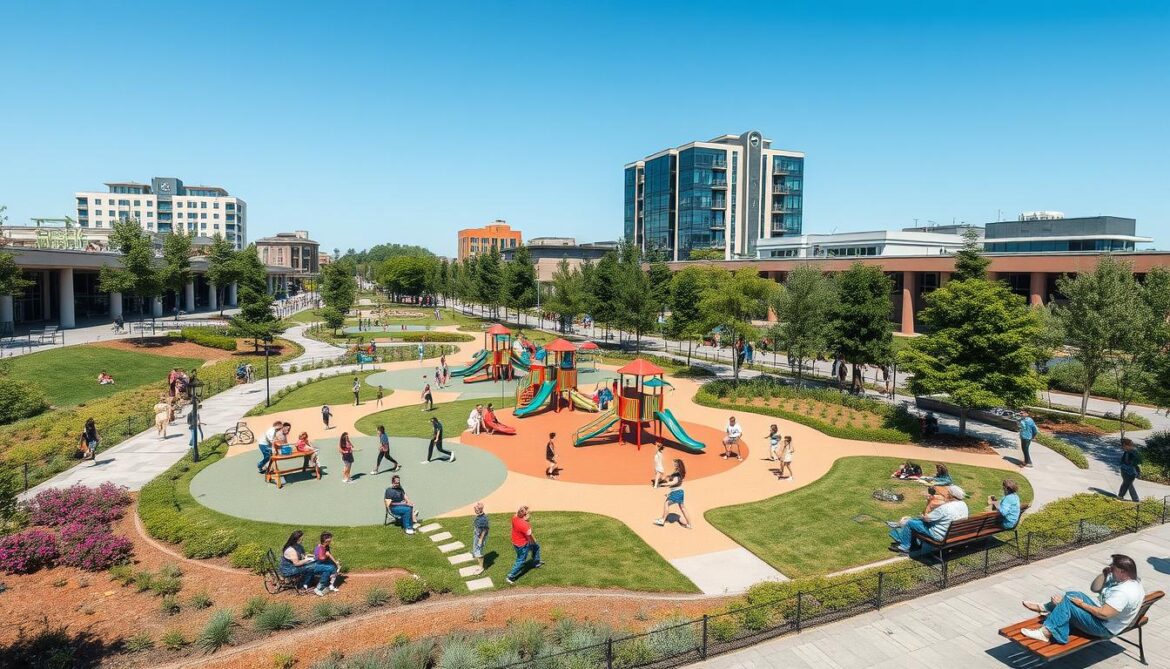
| Policy Changes | Funding and Investment | Collaboration with Non-Profits |
|---|---|---|
| Regulations that encourage green spaces, playgrounds, and multi-functional areas | Allocation of resources towards construction, renovation, and maintenance of public amenities | Leveraging expertise, networks, and volunteer efforts to enhance design, programming, and sustainability |
“By working together, local governments and non-profit organisations can create urban spaces that truly serve the needs of the community and foster a sense of belonging for all residents.” – Jane Doe, Urban Planner
Landscape Architecture Innovations
Sustainable design and nature-based solutions have become increasingly prominent in urban planning. Landscape architects are incorporating eco-friendly materials and practices to create spaces that not only serve recreational needs but also promote environmental sustainability11.
Sustainable Materials and Practices
The use of recycled and locally sourced materials is on the rise, reducing the carbon footprint of urban developments. Permeable surfaces, rain gardens, and green roofs are some of the innovative techniques employed to manage stormwater runoff and mitigate the urban heat island effect11.
Nature-Based Design Principles
Integrating natural elements, such as trees, native plants, and water features, into urban spaces is a key focus of contemporary landscape architecture. These nature-based design principles not only enhance the aesthetic appeal of public areas but also support biodiversity and climate resilience11.
Case Studies in Successful Urban Design
The Birmingham City Walk project in Alabama, for example, features a 50,000 square foot off-leash dog park, a 58,000 square foot skate park, and a 10,000 square foot amphitheater, all designed to promote community engagement and active lifestyles12. Similarly, Crescent Harbor Park in Sitka, Alaska, incorporates custom and themed play elements to cater to diverse age groups12.
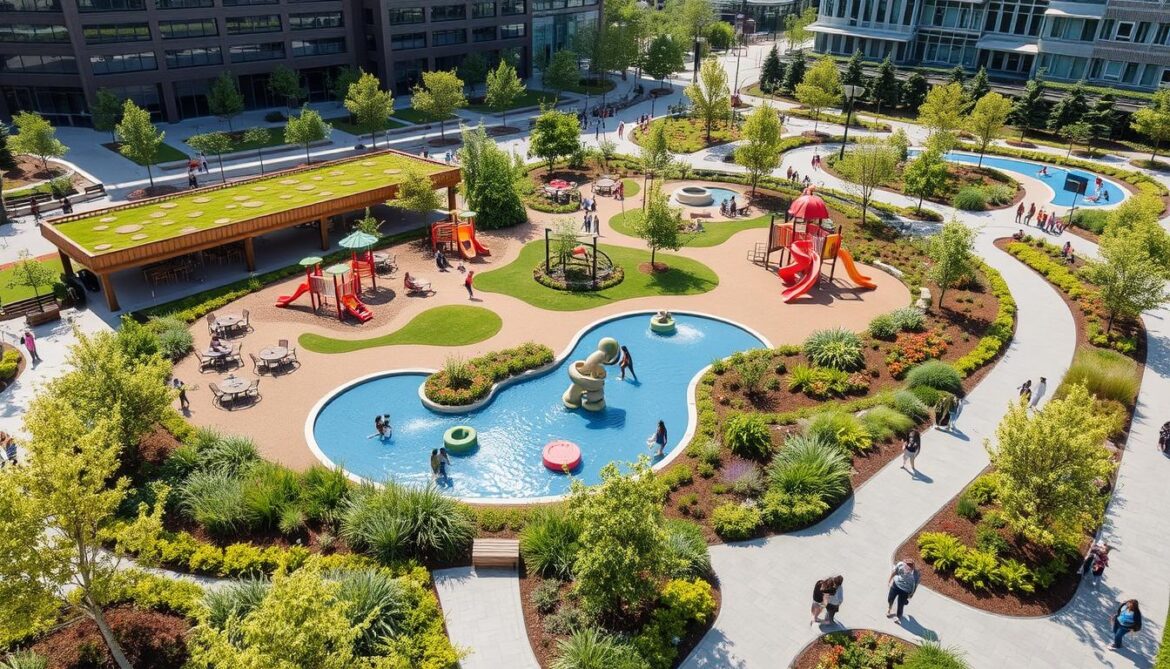
“The future of biophilic design in urban spaces is predicted to see an acceleration in sustainability in urban design, with policies promoting green construction and retrofitting existing urban environments.”11
Community Engagement Strategies
Effective community engagement is crucial for creating public spaces that cater to the diverse needs of local residents. By surveying the community and incorporating their feedback, designers can ensure that recreational areas and greenspaces truly reflect the preferences and priorities of those who will use them13.
Surveying Local Needs
Engaging with the community through surveys, focus groups, and public meetings allows designers to gain valuable insights into the specific needs and desires of local residents. This participatory approach not only fosters a sense of ownership but also helps to identify underserved populations and address their unique requirements13.
Volunteer Opportunities for Residents
Providing volunteer opportunities for community members to contribute to the development and maintenance of public spaces encourages a sense of stewardship and social cohesion. Residents can participate in activities such as gardening, cleanup efforts, and the installation of amenities, allowing them to directly shape the spaces they use13.
Partnerships with Schools and Organisations
Collaborating with local schools, community groups, and non-profit organisations can enhance the use and programming of recreational areas. These partnerships can facilitate educational activities, after-school programmes, and community events, thereby promoting the active engagement of diverse age groups and fostering a shared sense of ownership13.
By prioritising community engagement, designers can create public spaces that truly reflect the needs and aspirations of local residents, strengthening social cohesion and promoting a sense of belonging within the community13.
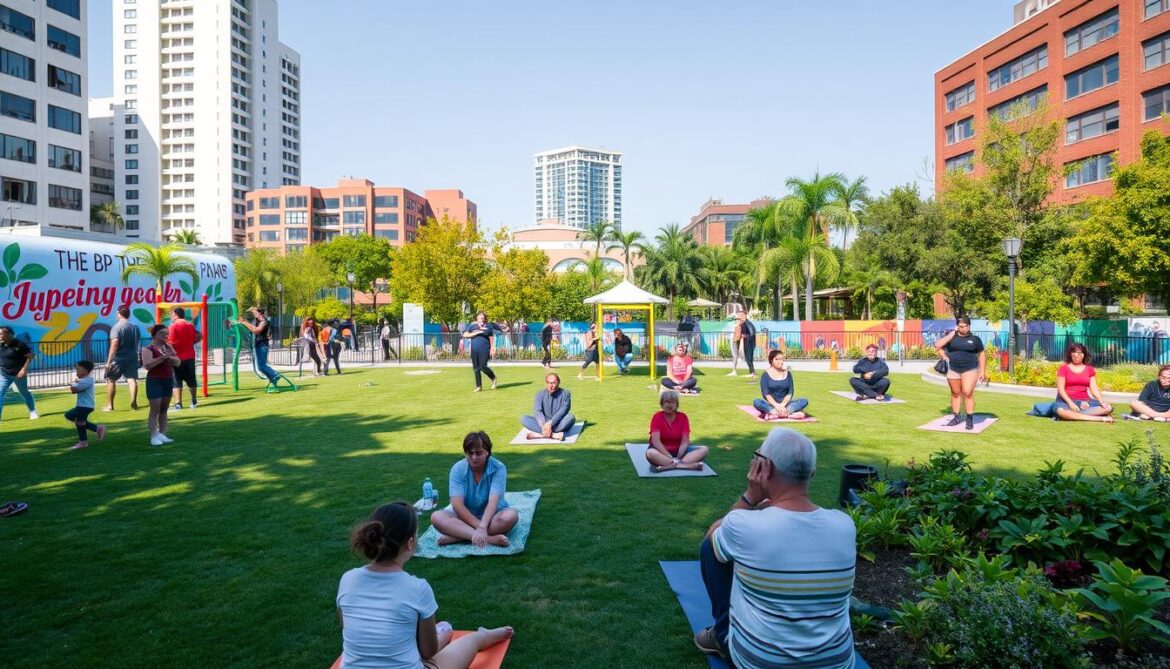
| Metric | Value |
|---|---|
| Published date | 03 September 2024 |
| Article accesses | 1,012 |
| Article citations | 5 |
| Recommended daily physical activity for children | 60 minutes |
| Children meeting recommended physical activity during COVID-19 | 28% |
| Decrease in children’s activity levels during pandemic | 11% |
| Canada’s rural community growth rate | Fastest among G7 countries |
| Child population in select counties | Oxford: 22,015, Elgin: 17,030, Middlesex: 83,160 |
“Well-designed public spaces have been shown to elevate the quality of life for citizens significantly, fostering social interaction.”13
By engaging the community, designers can create public spaces that truly reflect the needs and aspirations of local residents, strengthening social cohesion and promoting a sense of belonging13.
Integrating Technology in Recreational Spaces
Smart cities are embracing digital innovation to transform urban recreational areas, creating immersive experiences that blend physical and digital elements14. These technological advancements are not only enhancing the appeal of public spaces but also providing valuable insights to urban planners and designers for more effective development strategies.
Smart Playgrounds and Interactive Elements
Innovative smart playgrounds incorporate interactive features that captivate users of all ages. From augmented reality games to motion-sensing play equipment, these technologically-enabled spaces encourage active engagement and foster a sense of wonder15. By seamlessly integrating digital elements, smart playgrounds can cultivate a more dynamic and enjoyable recreational experience, appealing to the tech-savvy younger generation.
App Development for Community Mapping
Alongside smart playground installations, urban areas are leveraging mobile applications to help residents and visitors navigate and engage with local recreational spaces14. Community mapping apps allow users to easily locate parks, trails, and other amenities, while also providing information on upcoming events and activities. This digital connectivity empowers individuals to make the most of their community’s recreational offerings, fostering a stronger sense of belonging.
Data Collection for Enhanced Design
The integration of technology in recreational spaces extends beyond interactive elements and mapping apps16. Sensors and user feedback mechanisms enable the collection of valuable data that informs the design and maintenance of these public areas. By analysing usage patterns, usage, and user preferences, urban planners can make data-driven decisions to enhance the functionality, accessibility, and appeal of recreational spaces, ultimately creating environments that better serve the needs of the community.
The convergence of smart cities, digital innovation, and urban technology is transforming recreational spaces, making them more engaging, accessible, and responsive to the evolving needs of communities141516. By seamlessly blending physical and digital elements, urban areas are redefining the role of public spaces, fostering healthier, more connected, and vibrant communities.
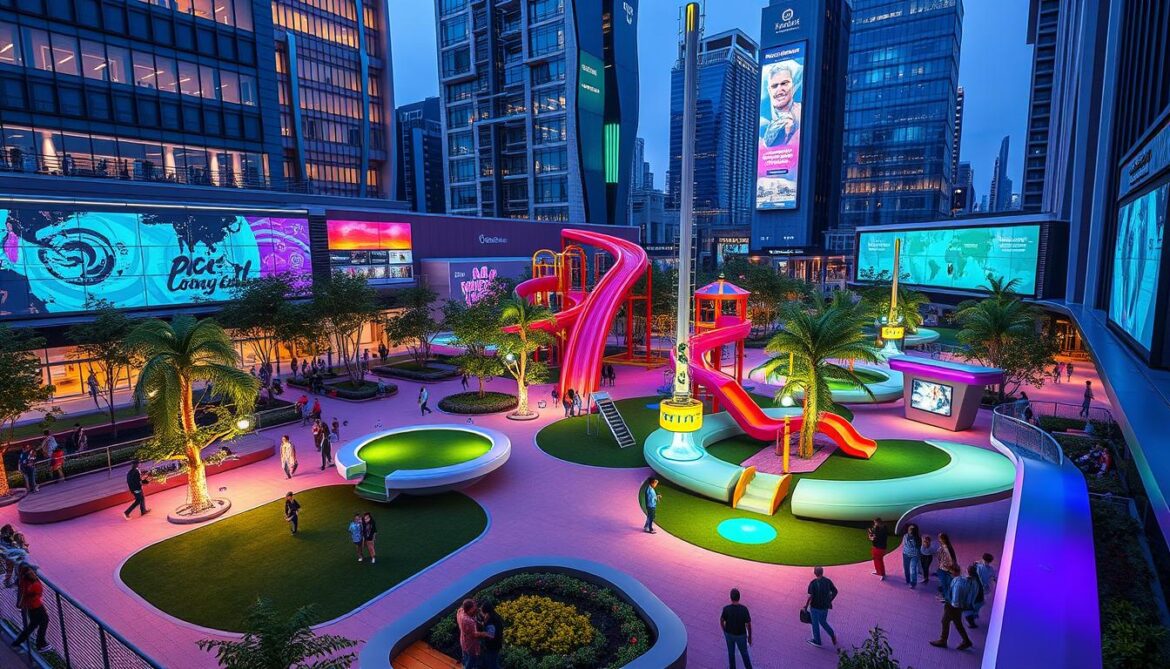
| Metric | Value |
|---|---|
| Percentage of people with moderate to severe anxiety or depression citing loneliness/isolation as a top factor | 70%14 |
| Percentage of parks reporting a decrease in revenue due to COVID-19 | 65.5%14 |
| Percentage of American adults considering parks and recreation as essential services | 82%14 |
| Percentage of park respondents expecting rising revenues in 2021 | 39.3%14 |
| Percentage increase in park visits before and after lockdowns | 63%14 |
| Percentage of park respondents from suburban communities | 45.3%14 |
“Greening” neighbourhoods reduces feelings of depression within communities, emphasising the importance of parks in mental health14.
The integration of technology in recreational spaces is not only enhancing the user experience but also providing valuable insights for urban planners and designers141516. By leveraging smart technologies, data-driven decision-making, and community-centric design, smart cities are redefining the role of public spaces, fostering healthier, more connected, and vibrant communities.
Cultural Considerations in Design
Designing inclusive recreational spaces requires a deep understanding of the local community’s cultural diversity. By celebrating the unique heritage and traditions of the area, these spaces can foster a stronger sense of community identity and belonging17.
Celebrating Local Heritage
Incorporating elements that reflect the community’s cultural heritage, such as public art, themed play structures, or landscaping inspired by traditional motifs, can help create a sense of place and pride17. These design choices not only beautify the space but also serve as a platform to educate and engage visitors about the area’s rich history and traditions.
Inclusive Representation in Recreational Areas
Ensuring that diverse community members see themselves represented in the design of recreational spaces is crucial for promoting a sense of belonging. This can be achieved through the inclusion of diverse imagery, signage in multiple languages, and the incorporation of elements that cater to the needs and preferences of various cultural groups17.
Flexibility for Diverse Activities
Designing recreational spaces with flexibility in mind allows for a wide range of cultural activities and practices to take place. This could include providing open-ended play areas, multi-purpose courts, or spaces that can accommodate traditional games, performances, or community gatherings18. By fostering this level of adaptability, these spaces become inclusive hubs that celebrate the cultural diversity of the local community.
Integrating cultural considerations into the design of urban recreational spaces is not only a matter of aesthetics but also a means of promoting social cohesion, community engagement, and a sense of belonging for all residents17. By embracing the rich tapestry of cultural identities within a city, these spaces can become vibrant, welcoming, and truly inclusive for individuals of all backgrounds.

Health and Wellbeing Initiatives
Urban recreational spaces are not just for leisure; they can also serve as hubs for promoting public health and active living within the community. From outdoor fitness classes to community gardening projects, these initiatives are transforming public spaces into vibrant centres of wellness and social engagement.
Outdoor Fitness Classes
Utilising the natural environments of urban parks and plazas, outdoor fitness classes encourage residents to incorporate physical activity into their daily routines19. Studies show that the risk of developing depression is 20% higher among city dwellers compared to those living outside cities, and the risk of developing more severe mental illnesses such as psychosis is 77% higher for townspeople19. These classes not only improve physical health but also foster a sense of community, as participants come together to improve their wellbeing.
Community Gardening Projects
Community gardening projects offer opportunities for residents to connect with nature, learn about sustainable food production, and build intergenerational relationships20. More than half (53.95%) of the participants in the study on urban year-round green exercise were female, while 46.15% were male20. These collaborative gardening initiatives not only promote active living and healthy eating habits but also contribute to the overall mental and social wellbeing of the community.
Mental Health Awareness Events
In addition to physical health, urban recreational spaces are also becoming venues for mental health awareness and support19. Air pollution was deemed to have actively contributed to a person’s death in a case in Great Britain where the victim was living next to heavy traffic with high nitrogen dioxide emissions19. Mental health awareness events held in public spaces help destigmatise mental health issues and provide resources for those in need, fostering a more inclusive and resilient community.
By integrating health and wellbeing initiatives into urban recreational areas, cities can enhance the overall quality of life for their residents, promoting public health, active living, and a strong sense of community wellness.
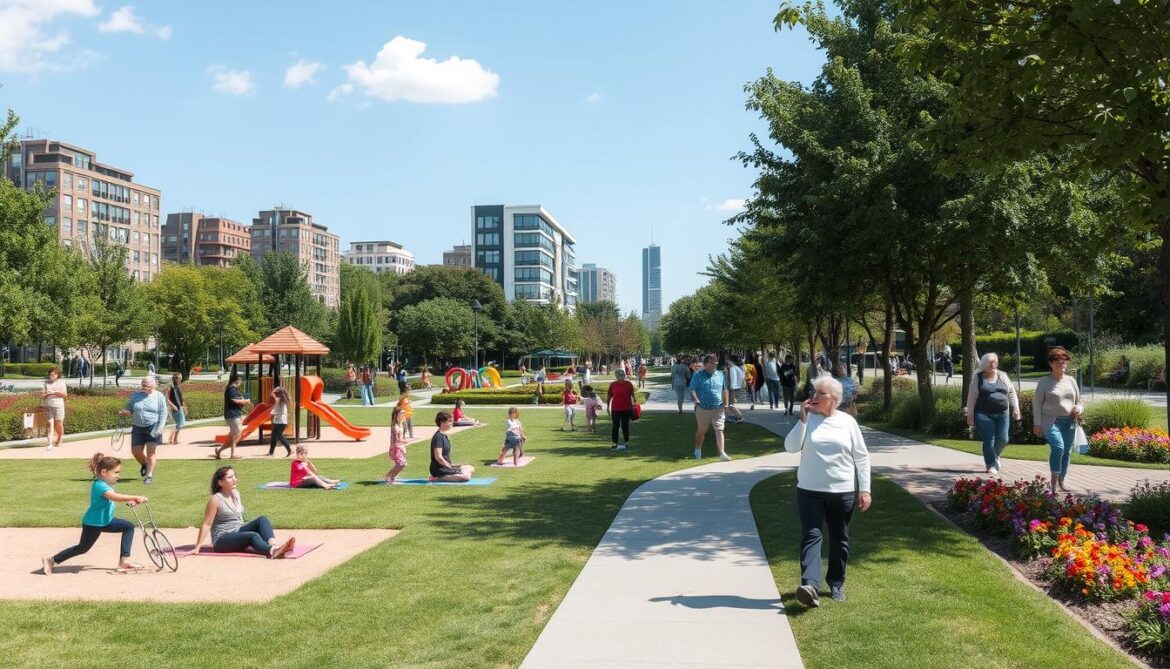
The Future of Urban Spaces
As urban futures unfold, the design of recreational spaces is set to undergo a transformative shift, emphasising adaptability and multi-functionality. Trends in urban planning suggest a growing preference for mixed-use developments that seamlessly integrate residential, commercial, and recreational amenities21. Between 2010 and 2020, mixed-use development accounted for nearly 50% of new commercial and multi-family development delivered, a figure that continues to rise21. Current data from ongoing projects in the Pipeline suggest that mixed-use developments approach 60% of total new development, indicating a clear preference over traditional single-use developments21.
Predictions for urban wellness point towards an increased integration of nature-based solutions and technology-enhanced experiences. The 15-minute city model, pioneered in cities like Copenhagen and Paris, aims to ensure that every essential service can be reached within a 15-minute walk or bike ride from home22. This concept of neighbourhood autonomy has been shown to reduce commute times and foster stronger community ties, while also delivering environmental benefits22.
Building resilience in urban environments will be crucial as cities face the challenges of climate change. Sustainable practices, such as the implementation of green roofs, are gaining momentum23. Green roofs not only reduce the urban heat island effect and improve air quality but also enhance biodiversity and provide accessible green spaces for urban dwellers23. Smart technologies integrated into mixed-use developments will further optimise energy use, manage resources efficiently, and enhance city services to support a more sustainable and resilient urban future21.
The future of urban spaces will likely emphasise sustainability, inclusivity, and the ability to foster strong social connections. By embracing innovative design principles, local governments, and community engagement, cities can transform into vibrant, livable, and resilient communities that prioritise the well-being of their residents212223.
“The 15-minute city model humanises large infrastructure projects by embedding growth management within urban environments.”
Trends in Recreational Design
- Adaptability and multi-functionality in mixed-use developments
- Preference for integrated lifestyle amenities within walking or biking distance
- Vertical integration of residential, retail, and office spaces in denser urban settings
Predictions for Urban Wellness
- Increased integration of nature-based solutions, such as green roofs
- Technology-enhanced experiences for improved resource management and city services
- Adoption of the 15-minute city model for neighbourhood autonomy and community ties
Building Resilience in Urban Environments
| Sustainable Practices | Benefits |
|---|---|
| Green roofs | Reduce urban heat island effect, improve air quality, enhance biodiversity, provide green spaces |
| Smart technologies in mixed-use developments | Optimise energy use, manage resources efficiently, enhance city services, ensure security |
Success Stories from Around the Globe
The quest for vibrant, liveable cities has inspired urban transformations worldwide. In Paris, Mayor Anne Hidalgo’s 15-Minute City initiative envisions residents having all daily necessities within a 15-minute walk or cycle24. Similarly, Melbourne’s 20-Minute Neighborhoods pilot aims to create vibrant communities where daily needs are met within a 20-minute walk from home24. Portland, Oregon, strives for 90 percent of its population to easily access essential services via a short walk or bike ride24. These examples, alongside initiatives in Singapore, Dublin, and Rome, showcase the partial implementation of the 15-Minute City concept globally24.
Notable Urban Transformations
The benefits of these innovative urban designs are evident. Paris and Melbourne have observed reduced vehicular pollution and improved air quality due to the 15-Minute City model24. Furthermore, cities adopting the 15-minute ethos, such as Portland and Singapore, have reported increased social cohesion and a greater sense of place among residents24. Enhanced public health outcomes, including more active lifestyles and reduced sedentary habits, have been observed in Dublin and Rome post-implementation of the 15-Minute City approach24.
Key Takeaways from Successful Initiatives
The success stories from around the globe highlight several key lessons. Thoughtful community engagement, sustainable design principles, and inclusive planning have been integral to the transformation of public spaces. Exemplary models like Singapore’s efficient urban planning, Denmark’s Dokk1 library in Aarhus, and Brazil’s Praca Victor Civita in Sao Paulo demonstrate the power of integrating public spaces into the cityscape25. Furthermore, community centres in Canada that offer tailored programs for diverse groups, such as immigrants, seniors, and youth, showcase the importance of catering to local needs25. These inspiring initiatives underscore the crucial role of public and community spaces in fostering personal development and community cohesion25.
Inspiring Communities Worldwide
The global success stories serve as models for future urban development projects, inspiring communities worldwide to rethink their public spaces. From the 15-Minute City concept to the creation of vibrant, multifunctional community hubs, these best best practices, urban regeneration, and global initiatives demonstrate the transformative potential of thoughtful urban design2425., As cities strive to enhance quality of life, promote social cohesion, and build more liveable environments, these success stories offer valuable insights and a roadmap for realising the vision of thriving, inclusive, and sustainable urban spaces25.
FAQ
How have playgrounds evolved over time?
What are the benefits of urban green spaces for individual and community well-being?
How can playgrounds be designed to be more inclusive?
How can public spaces be creatively used to revitalise urban areas?
What is the role of local governments in creating and maintaining recreational areas?
How are landscape architects incorporating sustainability in urban design?
What are the key community engagement strategies for creating successful public spaces?
How can technology be integrated into recreational spaces?
How can cultural considerations be incorporated into the design of public spaces?
What are some of the health and well-being initiatives taking place in urban recreational areas?
What are the future trends and predictions for urban spaces?
Can you share some successful urban transformation case studies?
Source Links
- Play Without Boundaries: Embracing Inclusion in Playgrounds – Landrec® | Playspaces – https://landrec.com/play-without-boundaries/
- Green Planning of Public Spaces: Integrating Nature in Urban Environments – Design Dash – https://designdash.com/2024/01/18/green-planning-of-public-spaces-integrating-nature-in-urban-environments/
- Value of urban green spaces in promoting healthy living and wellbeing: prospects for planning – https://pmc.ncbi.nlm.nih.gov/articles/PMC4556255/
- All You Need to Know About Inclusive Playgrounds & Play – https://adventureplaysystems.com/planning-tools/playground-education/inclusive-play/
- Designing Cities for Outdoor Play | Encyclopedia on Early Childhood Development – https://www.child-encyclopedia.com/outdoor-play/according-experts/designing-cities-outdoor-play
- Redefining Recreation Centers to Address Community Health and Well-Being | Operations | Parks & Recreation Magazine | NRPA – https://www.nrpa.org/parks-recreation-magazine/2024/january/redefining-recreation-centers-to-address-community-health-and-well-being/
- Redefining Infrastructure and Public Space – https://medium.com/reimagining-the-civic-commons/redefining-infrastructure-and-public-space-2e311edfde68
- Reimagining Public Space: Getting to Know the High Line Network – https://www.thehighline.org/blog/2020/05/11/reimagining-public-space-getting-to-know-the-high-line-network/
- BS R2-V7_Approved – https://urbact.eu/sites/default/files/2024-09/Baseline Study REGen R2-V7_.pdf
- Investing in Infrastructure for Healthy Communities – https://rpa.org/work/reports/infrastructure-healthy-communities
- The Rise of Biophilic Design: Integrating Nature into Urban Spaces – https://www.lorddecor.com/blog/the-rise-of-biophilic-design-integrating-nature-into-urban-spaces
- Landscape Architecture Month: Exploring the Role of Landscape Architects in Playground Design – https://www.gametime.com/news/landscape-architecture-month-exploring-the-role-of-landscape-architects-in-playground-design
- Public Spaces: The Power of Well-Designed – https://spanisharchitect.info/the-power-of-well-designed-public-spaces/
- The Emerging Parks And Recreation Industry Trends In 2022 – https://www.getomnify.com/blog/the-emerging-parks-and-recreation-industry-trends-in-2021-and-beyond
- A City Within a City: How Micro-City Design Breathes New Life into Multi-Use Concepts – https://architizer.com/blog/inspiration/stories/a-city-within-a-city-how-micro-city-design-breathes-new-life-into-multi-use-concepts/
- Creating Engaging Recreational Areas in Your Campground – https://crrhospitality.com/blog/creating-engaging-recreational-areas-in-your-campground/
- Examining Psychosocial and Economic Barriers to Green Space Access for Racialised Individuals and Families: A Narrative Literature Review of the Evidence to Date – https://pmc.ncbi.nlm.nih.gov/articles/PMC9819928/
- Creative Sports Spotlight – Building Big in the City: Urban Sports Facility Design Challenges – https://www.linkedin.com/pulse/building-big-city-urban-sports-facility-design-1vgee
- Sweco Group – Top urban health and well-being trends 2021 – https://www.swecogroup.com/topical/news/top-urban-health-and-well-being-trends-2021/
- Redefining Urban Recreation: A Demand Analysis for Urban Year-Round Green Exercise – https://www.mdpi.com/1660-4601/21/11/1483
- The Rise of Mixed-Use Developments in Future Cities – Tolj Commercial – https://toljcommercial.com/mixed-use-developments-in-urban-centers/
- A Game Changer for Urban Planning – https://www.e-zigurat.com/en/blog/discover-the-15-minute-city/
- Rooftop’s Innovative Approach: Revolutionizing Urban Spaces With Green Roof Technology – Residential and Commercial Roofing Contractor – https://rooftoprenovation.com/rooftops-innovative-approach-revolutionizing-urban-spaces-with-green-roof-technology/
- Understanding the 15-Minute City Concept – Design Dash – https://designdash.com/2024/01/18/understanding-the-15-minute-city-concept/
- PDF – https://file.pide.org.pk/pdfpideinpress/pip-redefining-urban-spaces.pdf






